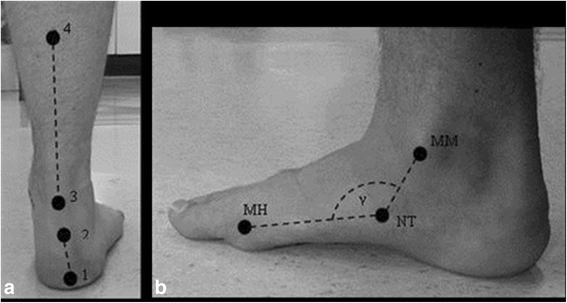Selected static foot assessments do not predict medial longitudinal arch motion during running
- PMID: 26464583
- PMCID: PMC4603633
- DOI: 10.1186/s13047-015-0113-6
Selected static foot assessments do not predict medial longitudinal arch motion during running
Abstract
Background: Static assessments of the foot are commonly advocated within the running community to classify the foot with a view to recommending the appropriate type of running shoe. The aim of this work was to determine whether selected static foot assessment could predict medial longitudinal arch (MLA) motion during running.
Methods: Fifteen physically active males (27 ± 5 years, 1.77 ± 0.04 m, 80 ± 10 kg) participated in the study. Foot Posture Index (FPI-6), MLA angle and rearfoot angle were measured in a relaxed standing position. MLA motion was calculated using the position of retro-reflective markers tracked by a VICON motion analysis system, while participants ran barefoot on a treadmill at a self-selected pace (2.8 ± 0.5 m.s(-1)). Bivariate linear regression was used to determine whether the static measures predicted MLA deformation and MLA angles at initial contact, midsupport and toe off.
Results: All three foot classification measures were significant predictors of MLA angle at initial contact, midsupport and toe off (p < .05) explaining 41-90 % of the variance. None of the static foot classification measures were significant predictors of MLA deformation during the stance phase of running.
Conclusion: Selected static foot measures did not predict dynamic MLA deformation during running. Given that MLA deformation has theoretically been linked to running injuries, the clinical relevance of predicting MLA angle at discrete time points during the stance phase of running is questioned. These findings also question the validity of the selected static foot classification measures when looking to characterise the foot during running. This indicates that alternative means of assessing the foot to inform footwear selection are required.
Keywords: Foot; Kinematics; Medial longitudinal arch; Running; Static foot assessment.
Figures

References
-
- Brody DM. Techniques in the evaluation and treatment of the injured runner. Orthop Clin North Am. 1982;13:541–58. - PubMed
LinkOut - more resources
Full Text Sources
Other Literature Sources
Miscellaneous

